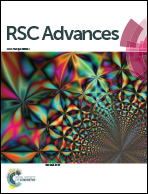Large area sub-100 nm direct nanoimprinting of palladium nanostructures†
Abstract
Direct imprinting of metals is predominantly achieved by using polydimethylsiloxane (PDMS) molds to pattern metal nanoparticles and subsequently melting them to form continuous structures. Although such a combination can successfully imprint metals, the yield and reproducibility are usually low when sub-100 nm features over large areas are desired. In this work, we demonstrate a simple method involving the addition of a cross-linker ethylene glycol dimethacrylate (EDMA) to a palladium metal precursor, and its in situ free radical polymerization during imprinting, which not only dramatically increases the yield to ∼100% but also enables high reproducibility. Palladium mercaptide resist was formed by dissolving acetoxy(benzylthio)palladium, EDMA and azobis-(isobutyronitrile) in an organic solvent mixture. The resist underwent polymerization when imprinted using a silicon mold at 120 °C with pressures as low as 30 bar. Polymerization rigidly shapes the imprinted patterns, traps the metal atoms, reduces the surface energy and strengthens the structures, thereby giving ∼100% yield after demolding. Heat-treatment of the imprinted structures at 330 °C resulted in the loss of organics and their subsequent shrinkage without the loss of integrity or aspect ratio and converted them to palladium nanostructures as small as ∼35 nm wide, over areas >1 cm × 1 cm. With suitable precursors, our technique can potentially be extended to pattern noble metals such as platinum, gold and silver.


 Please wait while we load your content...
Please wait while we load your content...